Jackson said those two weeks over holiday break can create a burden for families, since free school lunches won’t be provided.
“So those are two meals each day that they are now going to have to find that wasn’t necessarily in their budget,” Jackson said.
The universal free lunch program began in March 2020 after schools were forced to shut down during the beginning of the COVID-19 pandemic and was in place until July. Any student, at any public school, could get a free lunch. Restrictions around how meals could be served were lifted, so schools could send bagged lunches home with kids over weekends and breaks.
All students in Springfield schools can still get a free lunch due to federal guidelines, but the ability to send food home is no longer available.
To fill the void left by the absence of universal free lunches, schools have encouraged parents to fill out the free school lunch forms, offered food pantries to families to help at home and reminded families of school-run programs to assist families.
Springfield schools are working with Second Harvest Food Bank to provide food for community pantries at the schools, said Jenna Leinasars, spokeswoman for Springfield schools.
Lee Truesdale, chief development officer for The Foodbank, Inc., which serves Montgomery, Preble and Greene counties, said The Foodbank served 27,727 families with minor children between Aug. 1 and Dec. 5.
Truesdale said the time of year, with higher energy costs, can strain budgets, and high food costs are also hitting families hard this year.
Springboro Schools have a Community Assistance Center in partnership with the Springboro Community Assistance Center and Shared Harvest Foodbank. Scott Marshall, spokesman for the Springboro district, said there has been an uptick in the number of students and their families using the pantry.
“We do send food home for students who previously signed up through our backpack program, through the food pantry,” Marshall said.
Springboro is just one of many area school districts that have programs to send home food with their students even if the federal government is no longer providing money to do so. Northmont Schools provides backpacks of food for students to take home over weekends through the Community Table’s Backpack Food Friends program, and high schools and middle schools have Blessing Boxes – a standalone food pantry – available for families.
“The district will not be sending home food with students the way we did during the COVID years, but yes, we are being creative and working with families who may have exhibited need,” said Jenny Wood, spokeswoman for Northmont schools.
She added that, while it seems the demand is up, it’s not clear if the district has just done a better job reaching out to families who may need assistance this year or if there really is additional need.
Truesdale said the numbers this year are not necessarily higher than previous years, though the fiscal year is not yet over. Between July 2021 and June 2022, The Foodbank served 56,218 families with minor children, and between July 2020 and June 2021, the Foodbank served 62,304 households with minor children.
Truesdale said the high number of people served in the year ending June 2021 may be due in part to the tail end of tornado relief. The number doesn’t include four months when The Foodbank didn’t have to qualify people for their services, she added.
Jackson said the best way to help the local foodbanks is to donate money, as the organizations can stretch those dollars, but they also accept food donations and are always in need of volunteers.
Jackson said the people coming into the Second Harvest Foodbank often have jobs, but just need a little extra help, especially since it’s easier to find assistance with buying food than rent or medication help.
“If they’re able to get food from us, then they’ll be able to pay their rent, they’ll be able to get their medication, they’ll be able to keep their utilities on,” Jackson said.
About the Author

